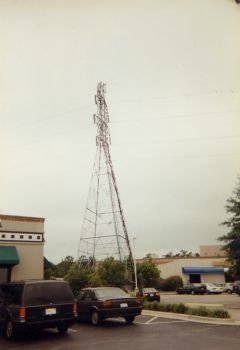CALL: 1-888-313-9750
Cell Phone Tower Lease Consulting & Coaching
Need Help? Call 888-313-9750
Our Cell Tower Co-location Experts Maximize Revenue For Landlords Leasing Space to Cellular Carriers.
|
|

What is cell tower co-location and why should you care if you are a landlord who has been approached by a cellular carrier or are fortunate enough to already be leasing ground space or rooftop space on your property or building?
Cell tower co-location (or sometimes spelled colocation or collocation) is the use of one structure to mount or deploy mobile telecommunications antennas belonging to more than one wireless service provider within a single location. Cellular collocation is simply adding carriers to cell phone towers, and if you are a wireless landlord with a cell phone tower landlords lease, this should be a top priority.
The concept of colocation is that you don't have to build multiple cell towers to have multiple carriers located on one property. You can have multiple telecommunications carriers placing there antennas onto one tower, where the anchor carrier, anchor tenant or tower owner is subleasing tower space or ground space to additional tenants.
The major cell tower management companies, Crown Castle International, SBA Towers and American Tower Corporation, all generate revenues by marketing their tower space and trying to place as many tenants as possible inside of their leased areas. Typically, when a cellular carrier such as Verizon Wireless, Sprint, AT&T, T-Mobile or US Cellular co-locates or subleases tower space from one of the major tower companies, the average cell phone tower rent paid for a colocation is $2,000 monthly. If landlords have subleasing or colocation language, otherwise known as revenue share, they can also benefit when a cell tower sublease occurs.
So is the proper terminology "Collocation" (Webster's), Colocation (Wikipedia) or Co-location (another variation commonly used in the telecommunication industry)?
In the cell tower industry we tend to use 'co-location' but let's take a further look...
Collocation (noun - Webster's) - is defined as the act or result of placing or arranging together.
Colocation (Wikipedia #1) - spells the word with ONE "L" and refers to the term as the placement of several entities in a single location as it relates to cell towers: In telecommunications, primarily wireless telecommunications facilities such as mobile wireless (cell sites) and radio broadcasting, it refers to the practice of locating multiple wireless broadcast facilities/providers within the same facility.
Co-location (Wikipedia #2) - makes reference to terminology used for Cell Towers in the United Kingdom: The term "base station site" might better reflect the increasing co-location of multiple mobile operators, and therefore multiple base stations, at a single site.
Let's look briefly at cell tower co-location and rooftop antenna collocation from the perspective of the municipality, the carrier and the landlord.
We are the USA's Premier
Cell Site Lease Consulting Services Firm.
Maximize The Value Of Your Cell Tower Lease.
Make Sense Of Confusing Cell Tower Offers.
Call Tower Genius 1-888-313-9750.
Cell Tower Co-location from the Municipal Perspective

1. The municipality wants to control the number of cell towers popping up in every corner of town, so they design cell site co-location ordinances that define the parameters of how cellular carriers may operate within their space. Generally, they require wireless service providers to look at existing structures first, such as rooftops, water towers, smokestacks, etc., to see if the existing infrastructure can support their antennas and also meet their coverage needs. Essentially, a town or city will try to force cell site colocation on carriers to lease space on municipal properties such as parks, town DOT facilities or water towers whenever possible.
Even if the site is feasible for the carrier, they still need to find a willing landlord, which does not guarantee an agreement will be reached. If a site is approved, a rooftop for example, that can support multiple sets of antennas for more than one cellular carrier, towns will try to force carriers to one location, where the co-locate on the same structure.
Cell Tower Co-location from a Carrier Perspective
2. The carrier who is the "lead" carrier, or the first one in, will almost always prefer to build a new tower if the coverage needs in the area will also require other carriers to improve their coverage. It is in the interest of the carrier who builds the cell tower to find other carriers to also deploy their equipment there as well, to help offset the site development costs. If the carrier is forced to co-locate on a rooftop, in many cases if the landlord is smart they will negotiate the lease so the carrier will not be able to offset construction costs with the addition of additional wireless carriers.
However, if a cell phone carrier like Verizon Wireless, T-Mobile, Sprint, DISH, AT&T or US Cellular puts their antennas on a landlord's roof, and they do not control the co-location rooftop footprint, they are not going to start searching for other carriers to offset their incurred construction and site development costs. The landlord is on their own to find additional carriers to rent space on their roof.
Cell Tower Co-location from a Landlord Perspective

3. The landlord or property owner who has a wireless carrier build a tower on their land or is approached by a cellular carrier to install antennas on their roof needs to get a fairly quick education in cellular antenna co-location strategy to make sure that they maximize their potential long-term rental revenues on the site, or they stand to lose out on six to seven figures of revenue.
Why Do Cell Tower Landlords Need Tower Genius?
Who is Tower Genius and why should you talk to us about cell tower co-location at your tower property or rooftop cellular site?
We are cell tower leasing and development experts with over 50 years of combined wireless industry experience. We help landlords who have already been contacted by carriers or who already have an existing cell site lease MAXIMIZE the profitability of their sites. We'd like to talk to you if you fall into the following categories:
1. You already have a tower with cellular antennas on your property and you being contacted to extend the lease, or they need your consent to expand or upgrade the site. If you don't already benefit from cell tower co-location don't miss the opportunity. Don't ask the the tower manager "if" you can have this provision in your lease. They will likely just tell you no. Have tower Genius analyze your deal before you begin to negotiate with them.
2. You already have cellular antennas on your roof and you think the carrier may have cut corners, or is not in compliance with the actual drawings or rooftop plans. For example, they were only allowed to lease 200 square feet of rooftop space, and after measuring their equipment platform, you see they are leasing 220 square feet of space, and have added equipment to the parapet walls that was not a part of the original lease.
3. You don't have a cell site lease yet BUT you've been approached by a wireless carrier who is interested in building a cell tower your property, and you want to make sure that you can maximize the value of your site. You probably have questions about tower lease rental rates, and after speaking to your attorney, you realize that know next to nothing about cell tower lease agreements.
Landlords who do not have a rock-star attorney who speaks "Telecom-Legalese" can literally blow the deal and any prospects of future collocation income for their landlord clients when an initial cell tower lease is signed.
Yes, that's the dirty secret that the carriers won't tell you before you sign on the dotted line. That is why you need a cellular leasing and wireless co-location expert on your side to level the playing field with the cell tower sharks who lease cellular towers at the cell phone companies.
If you have already been approached by a cellular carrier or are currently in a cell tower leasing contract, Contact Tower Genius to speak with a Cell Tower Co-location and Leasing Expert and discuss how to maximize the value of and profitability of your cell phone tower leases.
|
Find out from Tower Genius how we help landlords and property owners in the USA maximize cell site lease values and get the best possible terms for: |
|
|
Need help with your cell tower lease?
1-888-313-9750
Wireless Telecom Consulting & Transactional Coaching for Landlords and Landowners.





